Predictive Change Management
Hacking Team
Change management and change initiatives in the broadest sense of the word are typically a combination of formal and informal activities and processes. Whilst change has traditionally been driven in a top-down fashion, new tools and techniques are emerging that help create a complementary, bottom-up approach. Methods such as social network analysis, innovation management, crowd sourcing and enterprise social networks have all emerged as approaches to support change and innovation in one way or another. That said, these new tools are all software-centric and what's missing from this picture is the shift in mindset to where change and collaboration is people focussed as much as it is technology focussed. This idea is well summarised by David Coleman who wrote:
The biggest challenge I have found over the years is something I have blogged about in the past which I call the “Collaborative Shift.” This is a change to a mindset that is more open and transparent, willing to work and share with others, and sees the team, group or community as important, or more important than themselves. For some people this can be a big shift. But we have to change our mindset before we can change behavior (and make it stick).
The Hack
Given the need to focus on the human side of change and with the objective of 'creating an army of change agents' in mind, there are two complementary routes to achieving this. The first evolves around identifying people who are intrinsically more open and curious about change, while the second concerns adding context and establishing practical actions points.
The Hack in Practice - Identifying Change Pioneers and Early Adopters
4G makes it possible to identify people who, in principle, are much more likely than average to pioneer change and adopt new methods and approaches ahead of others. Of the 16 Social Profiles, 4 are considered 'pioneers' and 4 are 'early adopters'. For the sake of definitions, pioneers are the idea generators, while early adopters are often the first to try out a new idea and to put change into practice.
The 4 pioneers (summary descriptions of each of the Social Profiles below can be found here):
- 1Ne
- 2Ni
- 3Ni
- 4Ne
The 4 early adopters:
- 1Ti
- 2Fe
- 3Te
- 4Fi
It's also worth saying at this point that 4G also helps identify Social Profiles that are, in principle, the least likely to embrace change:
- 1Fe
- 2Ti
- 3Fi
- 4Te
In diagram 1, Leanne (2Ni), Alberto (3Ni) and Sam (3Ni) are all pioneers, while Gerald (3Fi), Tejash (3Fi) and Louise (4Te) may be more sceptical of any proposed change.
Knowing if a particular person is a 'pioneer', 'early adopter' or 'sceptic' is itself insufficient to create an army of change agents. While possible candidates can be easily identified, contextual and organisational information must also be considered if people are to 'sign up', 'be recruited', or 'conscripted', as the case may be.
The Hack in Practice - Adding Context via Social Groups
Knowing someone's propensity for new ideas and change in isolation is one thing but in order for this to be useful, the context of any change needs to be factored into the equation. Part of the context consists of classic change management considerations such as the change itself, the business case, the individual’s own career and personal objectives, how long the change will last, how much it costs, what elements of value might be lost as a result of the change and so forth. All important and fundamental.
The other part of the context consists of analysing the culture and values related to the change. From a 4G perspective, Social Groups define shared values and group cultures. Diagram 2 offers an introduction to each of the 4 different Social Groups, along with providing a proxy for the Cynefin model.
Social Groups are important for two reasons. Firstly, they define ideal or optimal teams of 4 people who each share a Relationship of Action (motivation and energy), Balance (boosting strengths and minimising weaknesses) and Reflection (feedback and critical thinking). Each of the 4 groups of 4 sharing these relationships can be seen in diagram 3.
The second reason Social Groups are important is because they create a mirror for the organisation's own context and commercial values. Put another way, Social Group data acts as the cultural equivalent of an organisation's strategy and optimal business environment. Perhaps the simplest way to explain this is by linking the ideas behind market growth to those of Social Groups. As per diagram 3, each of the 4 Social Groups corresponds to a different stage of the product life cycle[1]:
- Social Group 1: Innovators
- Social Group 2: Early Adopters
- Social Group 3: Mass Market/Early Majority
- Social Group 4: Late Adopter/Late Majority
The Hack in Practice - Some Examples
By linking specific Social Profiles to Social Groups and triangulating this with an organisation's commercial and operating context, it's possible to gain deep insights into change processes and to identify people who are best placed to influence, lead or faciliate change in a given situation. In addition, this approach to change has the added advantage of working in both top-down and bottom-up environments.
1. How Culture, Values and Relationships Undermine Top-Down Change
Social Group 3 is at it's best in environments where cause and effect relationships are apparent, change is commercially justified and making a practical difference is a priority. Likewise, structure and processes are important, along with targets, data, plans and a tactful and diplomatic working style. Contrast this with Social Group 1 who excel in environments with limited or even no structure where originality, spontaneity, passion and experimentation are important. Equally, radical propositions and blue sky thinking are also highly valued by Social Group 1. Given these contrasts and their implications for culture, change and prioritisation, the information in diagram 4 should come as no surprise.
Diagram 4 shows how everyone in Social Group 3 shares green relationships, but that yellow and red lines are drawn between the people in Social Group 3 and 1. When it comes to change, it's easy to see how a top down approach from the leadership team in Social Group 3 may well create delays, resistance or scepticism from the team in Social Group 1.
The example in diagram 4 shows how top down change can often come unstuck as a result of cultural or relational factors. Culture and relationships are also good substitutes for some of the key barriers to change; commitment, passion, drive, involvement, vision, leadership and communication. In this instance the combination of Social Profiles, Social Relationships and Social Groups create a common denominator for barriers to change above.
2. Changing Structures to Support Top-Down Change
While diagram 4 illustrates how top down change initiatives can struggle when faced with contrasting cultures and challenging relationships, diagrams 5 and 6 show how these problems can be overcome.
In diagram 5, Fraser is attempting to change the way that Ajay works. Both are highly skilled and experienced but given the difficult relationship between them, Fraser's efforts are proving frustrating. In addition, Ajay finds the conflict very stressful and begins to fear that his anticipated promotion is going unlikely to happen as a result.
As 4G predicts the outcome of relationships in advance of people meeting or working together, Fraser knows that Jim will be a great intermediary, as shown in diagram 6. Jim's blue relationships with Fraser and Ajay make for much easier communications and by stepping in, both Fraser and Ajay save time and don't continue to struggle with what was a very difficult issue.
It's also worth noting that the change proposed in diagram 6 can be implemented formally or informally and can be seen either as a short term intervention lasting a few weeks to a couple of months, or may last for 6 months or more, depending on the situation. Finally, while Fraser, Jim and Ajay are all either 'pioneers' or 'early adopters', the Social Relationships that they share will be more important in this instance than their own Social Profiles.
3. Bottom Up Change and Avoiding Obstacles
Diagram 7 shows a group of 10 people who together share 45 Social Relationships. When it comes to empowering bottom up change and creating an 'army of change agents', giving people access to 4G data is one way to facilitate this. Given the complexity within the team of 10 (e.g. there are 252 different ways to create a team of 5), knowing how everyone's relationships unfold makes a huge difference in terms of enabling change and improving communication.
The following examples help facilitate any change initiative, improved paths of communication and efforts to influence members of the group:
- George could work with Kate or Fraser to influence Mark (and vise versa)
- Janet could work with Mark or Jim to influence Ajay (and vise versa)
- Hugh could work with Rehan to influence George (and vise versa)
- John could work with Hugh or Rehan to influence Fraser (and vise versa)
By giving individuals access to the information from 4G and incorporating the concepts from Hack HR 1, it's possible to empower individuals with unique information that can directly impact their approach to instigating and managing change. In addition, because 4G can be used in a scalable and consistent manner, the tool is able to support top down and bottom up initiatives in equal measure.
Implications
The predictive and culturally contextual information from 4G has a number of applications in change-orientated scenarios:
- Identifying people in a reliable and scalable manner who are likely to be either enthusiastic or sceptical about change in advance of any action leaves practitioners and processes better informed and better prepared.
- Specifically, the data and insights from 4G have the potential to enhance change orientated decision making, organisational design, restructuring, merger integration and aid the alignment of culture, strategy and business processes, at a team, departmental, divisional or organisational wide level.
- Sharing the information from 4G with relevant people enhances trust and transparency, whilst removing blockages and barriers to the flow of information and good communications.
Footnotes
1. It is important to distinguish between the following two concepts. Firstly, a particular Social Profile may have pioneer or early adopter characteristics as an element of an individual's Social Profile. Secondly, Social Group 1 and Social Group 2 can be thought of a collective versions of pioneers and early adopters and need to be viewed as having distinct and separate values and definitions when compared to an individual's own Social Profile.
Please read the other hacks I've submitted:
- Predicting Relationships and Group Values - Creating A New Mental Model and Set of Conceptual Skills
- Relational Recruitment and Optimising Team Creation for Group Cohesion
- Better Engagement through Enhanced Decision Making, Personalised Coaching and Aligning the Management of Processes and People
- Linking HR Metrics to Financial Outcomes - Quantifying Behaviour and Linking it to the Bottom Line
- 6 Processes for HR Transformation
Bruce, I had a look at your website and the introductory video which demonstrates the tool beautifully.
What tools and techniques do you use to ascertain a person's profile in the context of change? I know myself fairly well and know that in certain areas I am an Early Adopter e.g. collaboration platforms and in another area I would probably be a Late Adopter (or even a Laggard), e.g. mobile technology. Both examples are technology related yet my response to both is very different.
I like the opportunity your technology gives to read up on the best way to communicate across the different profiles, which I am sure will help build rapport and reduce conflict.
Hi Heidi, thank you for your thoughts...
Ascertaining someone's profile is through a combination of a psychometric and a semi-structured feedback interview which focusses on the individual themselves and the themes raised in the instrument. From there, all the 4G change data is available and this can then be linked back to other factors.
It's hard to answer your question about your personal view of being an Early Adopter or Late Adopter without knowing more about the context, what is more important to you and a host of similar questions about how you view a specific example of change and change in general. That said, when it comes to applying the data from the tool in a change orientated context, there's basically four elements that need to be aligned, depending on the nature and scope of the change in question.
The rest of this answer may be more abstract that is ideal, but hopefully it sheds some more light on these themes, although given the complexity and contextual drivers, change management processes are often more complex than simpler activities such as recruitment, onboarding or team creation for example.
The first element is the general context around the change itself, e.g. the business case, objectives of the change, recent history and how the change was conceived, initiated, implemented etc. In and of itself, this first element has a number of nuances and can't really be generalised, other than in a very superficial manner.
The second element concerns the individual, comprised partly of their opinion of the change, 'what's in it for them', their skills and experience, their perceptions, motivations and so forth. The other part consists of their 4G Social Profile and of the 16 possible profiles, are they an early adopter, pioneer or sceptic, as outlined in the Predictive Change Management hack.
Thirdly, what 4G Social Relationships do they share, both with existing colleagues and with any new people they might be working with. Incorporating the relational perspective, if relevant to the change work, helps establish if the individual is well placed to work well with others on the change, to act as an influencer or champion, or if they might be a sceptic and may need, or might want to hear about the change from someone else who communicates with them in a different but more appropriate manner (i.e. change the messenger, not the message).
The fourth factor is that of Social Groups, again, another input from 4G, available after the psychometric and feedback session. This element focusses on shared values, team climate and cultural factors, which may or may not be relevant, depending on the change in question. One way to think about Social Groups is like a 4 stage market life cycle, innovation, early adoption, mass market and late adopter, but a better definition would be to see each Social Group as having a preference for more or less structure. Thought of in this fashion, a group of people working together in Social Group 1 excels in environments with the least structure and the greatest freedoms, all the way through to Social Group 4, which seeks out the most mature/structured and well understood environments. The Social Groups are analogous to the Cynefin model.
I don't know if the above is of any use in answering your question, but hopefully it add some more detail in terms of how the 4G tool can aid change management work.


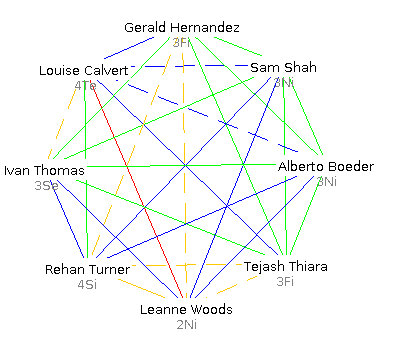
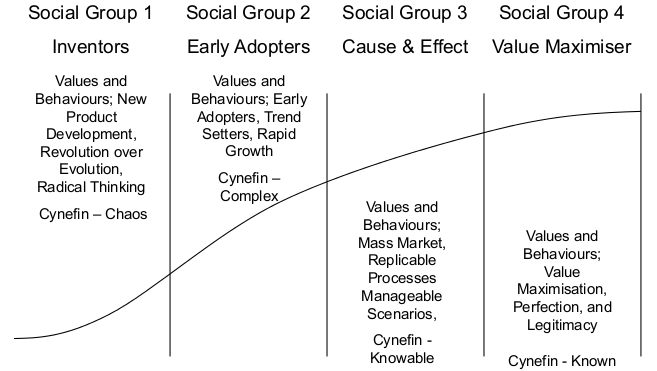

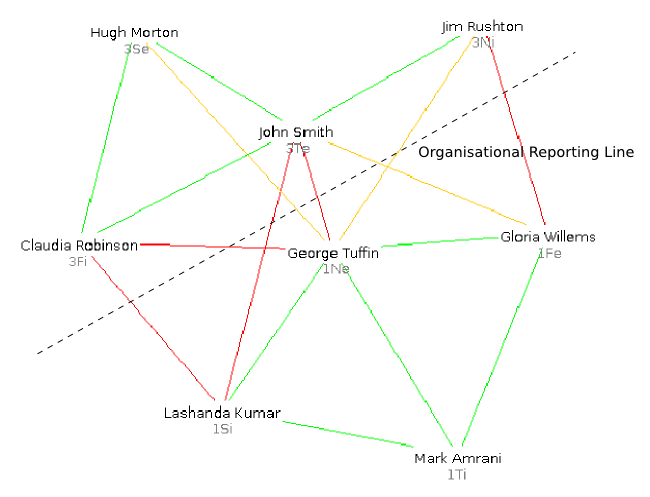
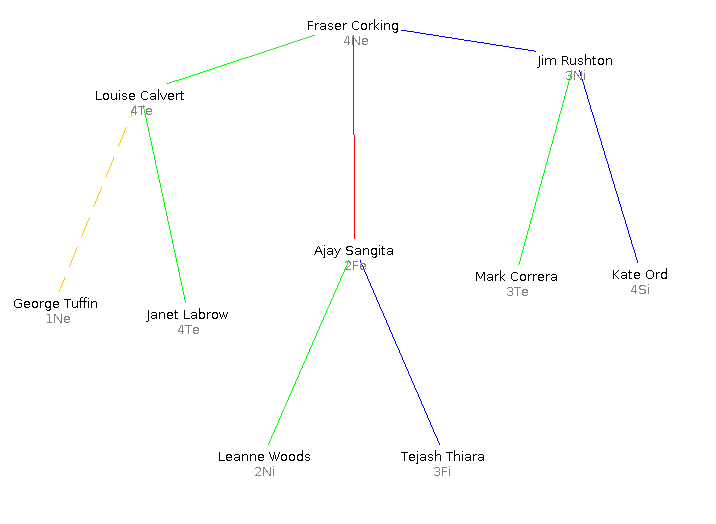
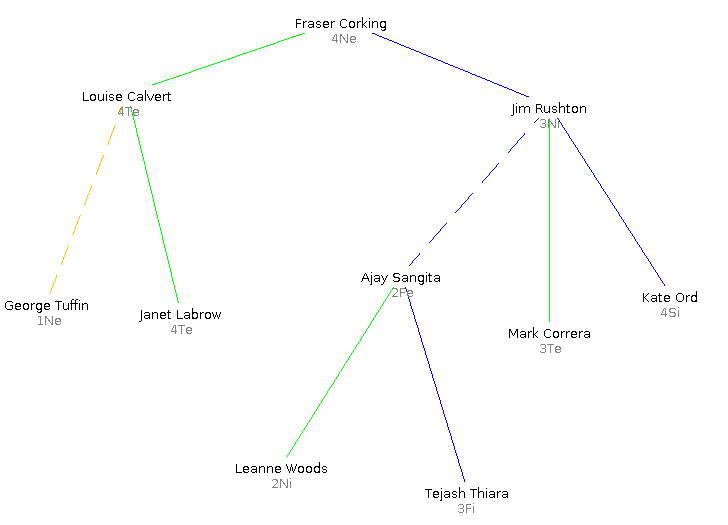
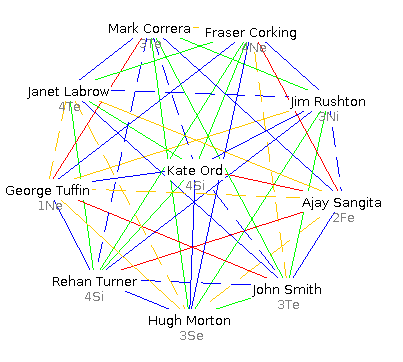

You need to register in order to submit a comment.